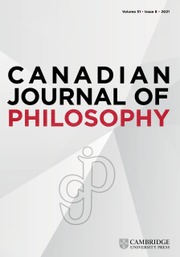No CrossRef data available.
Article contents
Hope and Fear as Co-Variable Attitudes
Published online by Cambridge University Press: 02 July 2025
Abstract
I offer a critique of the method of analysis employed in Carl-Johan Palmqvist’s article The Mirror Account of Hope and Fear when arguing against the co-variation thesis (CVT). I show that the analysis of CVT—which uses the notational convention of representing a hope as “p’ and its supposed corresponding fear as “¬p’—is problematic in that it potentially obscures the divergent propositional content of hopes and fears. As an antidote, I suggest representing the propositional content of hopes and fears with distinct placeholders p, q, and etc. and I show how this refinement in method allows us to make progress on the issue of co-variation.
Information
- Type
- Discussion Note
- Information
- Copyright
- © The Author(s), 2025. Published by Cambridge University Press on behalf of The Canadian Journal of Philosophy, Inc
References
Calhoun, C. (2018). Doing valuable time: The present, the future, and meaningful living (pp. 1–190). Oxford University Press. https://doi.org/10.1093/oso/9780190851866.001.0001.CrossRefGoogle Scholar
Day, J. P. (1970). The anatomy of hope and fear. Mind, 79(315), 369–384. https://doi.org/10.1093/mind/lxxix.315.369.Google Scholar
Day, J. P. (1998). More about hope and fear. Ethical Theory and Moral Practice, 1(1), 121–123. https://doi.org/10.1023/a:1009941103193.Google Scholar
Downie, R. S. (1963). Hope. Philosophy and Phenomenological Research, 24(2), 248. https://doi.org/10.2307/2104466.Google Scholar
Frege, G. (1948). Sense and reference. The Philosophical Review, 57(3), 209. https://doi.org/10.2307/2181485.Google Scholar
Kwong, J. M. C. (2020). Hope and hopefulness. Canadian Journal of Philosophy, 50(7), 832–843. https://doi.org/10.1017/CAN.2020.30.Google Scholar
Kwong, J. M. C. (2022). How to theorize about hope. European Journal of Philosophy, 30(4), 1426–1439. https://doi.org/10.1111/EJOP.12757.Google Scholar
Palmqvist, C. J. (2023). The mirror account of hope and fear. Canadian Journal of Philosophy, 53(3), 209–223. https://doi.org/10.1017/CAN.2024.2.Google Scholar
Vazard, J. (2024). Feeling the unknown: Emotions of uncertainty and their valence. Erkenntnis, 89(4), 1275–1294. https://doi.org/10.1007/S10670-022-00583-1/METRICS.Google Scholar

